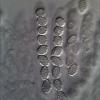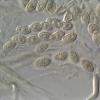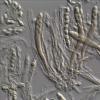
21-12-2025 09:32
Hello.A tiny ascomycete found embedded in wood in

22-12-2025 00:47
Patrice TANCHAUDBonsoir, récolte à proximité du milieu dunaire

21-12-2025 21:32
Pol DebaenstHello, Garden, Burgweg 19, Veurne, BelgiumOn 10/1

21-12-2025 21:40
Isabelle CharissouBonjour, j'aimerais connaitre les références de

21-12-2025 21:31
Pol DebaenstHello, Garden, Burgweg 19, Veurne, BelgiumOn 10/1

21-12-2025 21:31
Pol DebaenstHello, Garden, Burgweg 19, Veurne, BelgiumOn 10/1

20-12-2025 23:08
Patrice TANCHAUDBonsoir, récolte sur sol sablonneux dans l'arri�

20-12-2025 15:47
Mirek GrycHi.These grew on pine wood that was heavily covere
You might be interested in this species; it was originally described by Rodway from Tasmania in 1925 but appears to have turned up recently in southern England. Quite an extreme disjunct distribution! The British collections were identified by Brian Spooner. The problem is that it doesn't fit in Mollisia, even in its traditional exceptionally broad sense, but we can't find a suitable home for it. Does anyone have any suggestions, and has anyone happened to collect it elsewhere in Europe?
A description and a couple of images are given below; there is more information and pictures at http://fungi.myspecies.info/all-fungi/mollisia-subglobosa. Click on the Descriptions and Media tabs on that page to see more.
All help will be gratefully received
Paul
Ascomata apothecia, formed singly or in compact clusters of up to 10-12, rather irregular in form but initially circular and discoid, the margins becoming convoluted especially in clustered ascomata, not gelatinized. Disc grey-green, the margin and underside initially pale, the undersurface becoming mid brown with age. Outer wall (ectal excipulum) composed of irregular dark brown angular cells 7-13 µm diam., with an outer layer of hyaline to pale brown cylindrical to clavate cells measuring 8-11 x 3-4 µm. Subhymenial layer composed of poorly defined hyaline hyphal tissue. Interascal tissue of copious unbranched thin-walled paraphyses ca 2 µm diam., sometimes slightly inflated with narrowly clavate tips. Asci 72-87 x 4-5.5 µm, narrowly clavate with a long tapering stalk, the base sometimes forked indicating the presence of croziers, uniformly thin-walled, the apex obtuse to rounded, with an apical ring 2-3 µm diam. and ca 1 µm thick that stains blue in Lugol's iodine, the ascus contents dextrinoid in Melzer's reagent, 8-spored. Ascospores arranged uniseriately, 4.5-5.5 (-6) x 3-3.5 (-4) µm, ellipsoidal or rarely fusiform-ellipsoidal, aseptate, hyaline or very pale yellow in mass, fairly thin-walled, strongly reticulate, the network 0.75-1 µm diam., without a gelatinous sheath or appendages.

thanks for sharing this wonderfull species with us, I have no Idea for a existing genus but my preference goes to somewhere among the Encoelioidae. I suppose no ionomidotic reaction was observed.
best regards,
Stip

could you please tell us the substrate of this collection? My idea is that it is my Pyrenopeziza "ulicis", see below. Recently Brian Douglas considered this to be close to Mollisia dextrinospora, though I did not notice any iodine reaction of the spores of my studied samples.
Did you look at the living paraphyses? Mollisia always has refractive vacuoles (VBs) whereas Pyrenopeziza lacks them.
Rodway's descriptions are very brief, so how is it possible to identify a fungus with them? But I see that Thind & Singh 1972:49 (Helotiales from India XVI) described for M.subglobosa a spore size almost exactly as here. I am not at home so I cannot look into the paper.
Zotto
I agree with Zotto - I think your species does resemble Pyrenopeziza 'ulicis', as well as 'Mollisia' dextrinospora when examined when living (my collection from near Chichester, UK, had an identical ITS sequence to the type). I'd guess it is fairly closely related to these species, if not conspecific to Pyrenoepziza 'ulicis' and Mollisia dextrinospora.
As Zotto said, the morphology when living is very similar, apart from a) the ascospore warts in your collection and in Pyrenopeziza 'ulicis', and b) the dextrinoid reaction in my collection and the type of Mollisia dextrinospora. I suspect these are probably good taxonomic differences, but I'm not totally sure without DNA sequencing. Your collection also seems to have the two polar lipid bodies in the non-warted ascospores (hidden in the warted ones because of DIC?), which seems to be a good character in most of the collections in this group. The paraphyses (if living) should also contain a few faintly visible globular vescicles that stain well with brilliant cresyl blue.
If your collection is close to Mollisia dextrinospora, then description from Tasmania may not be as unusual as it seems! Mollisia dextrinospora (originally described from Madeira) has been detected in Kiwi fruit vines in New Zealand, and members of the broader group are globally distributed under the names Cadophora fastigiata/Cadophora melinii, including in Australia. Mollisia dextrinospora and Pyrenopeziza ulicis seem to overlap with Ellis and Ellis's concept of Mollisia aquosa in Microfungi on Land Plants (which does not fully resemble the type description), so a UK presence would also not seem strange.
The Mollisia dextrinospora/Cadophora fastigiata/Cadophora melinii group appears to contain quite a few non-host-specific lignicolous species. It's placed basally to the core Pyrenopeziza clade at the moment, and I think it should be included in Pyrenopeziza, at least for now.
Mollisia subglobosa is an interesting potential earlier synonym. If anyone has a PDF/scan of Rodway's original description and Thind & Singh 1972:49 (Helotiales from India XVI), I would very much appreciate a copy!
Cheers,
Brian
This post and discussion raise a number of interesting points.
I featured Mollisia subglobosa Rodway in my book 'Ascomycetes in Colour Found and Photographed in Mainland Britain'. The fresh fruit bodies were a dull green to brownish green and collected in the New Forest, Hampshire growing on dead wood of Ilex aquifolium.
As with the sample being discussed here, the spores of my sample had a reticulate pattern rather than warts. Also, some of mine were slightly longer, at up to 8um.
I accepted the identification from Brian Spooner, RBG Kew, but subsequently learnt that he made many mistakes identifying my discomycete samples. It seems that Rodway's description mentions smooth spores rather than warts or a reticulate pattern, so there is an inconsistency.
Fresh collections of Pyrenopeziza ulicis seem to be very pale, without green pigmentation and with warted spores. If it is restricted to Ulex, then the collection on Ilex presumably differs.
I believe that Mollisia aquosa has smooth spores, but again, they are of similar shape and size and previously found in Britain.
I also wonder to what extent the geographical location of previous finds of ascomycetes is important in these days of fast travel between continents. In Britain, I have recently found fruit bodies which seem macroscopically and microscopically identical to Pseudohelotium haematoideum (originally New Zealand 1879), and Lachnum lunatum (originally China 1997).
With Best Wishes,
Peter.
Kind regards
Paul
Thind, K. S. & Singh, H. (1972), The Helotiales of India - XVI. Journal of the Indian Botanical Society 51 : 44-51
A pdf of the entire journal volume can be requested at an Indian science doc repository. Here's the direct link: http://krishikosh.egranth.ac.in/handle/1/22854
Best wishes,
Eric
Paul
Firstly, Brian Spooner is human like the rest of us and may occasionally be in error, but this time I think he's absolutely correct. We have a preserved slide at Kew taken from the holotype of M. subglobosa in Hobart, and it has reticulately ornamented spores just like those from the British specimen. So preserved material does have some value... An image from the type is attached so you can compare them - the ascospores in the type seem to be very marginally narrower than those of the British material, but there is quite a lot of overlap and this does not provide a reason for separating them. I'm sure Rodway's microscope wasn't so good, which is why he referred to the spores as smooth.
Secondly, I can confirm the dextrinoid reaction in Melzer's (this information came from the original collector and I hadn't tried it myself): it seems that the entire ascus contents become pigmented, not just the spores.
Thirdly, I've looked at the Thind & Singh paper (they describe a collection identified as M. subglobosa from India with some nice drawings). I'm not convinced this is the same species, though it is likely to be closely related; the outer layer of the excipulum looks a bit different and the spores are described as verrucose rather than reticulate.
Fourthly: Zotto's fungus on Ulex is probably a close relative of M. subglobosa but differs in ascospore ornamentation and substratum: the British collections of M. subglobosa are all on Ilex bark/wood and consistently associated with Nectria punicea var. ilicis. The type of M. subglobosa is also associated with a Nectria species.
Fifthly: I'm not sure whether M. dextrinospora fits here as it has smooth spores and asci that don't stain blue in iodine, according to the original description; maybe Brian can confirm this. We therefore seem to have two (and possibly three) closely related species, which one day might perhaps deserve their own genus. But that would require DNA and a comprehensive revision of this gloriously complicated genus Mollisia (not to mention Pyrenopeziza).....

thanks for these news! Here a few comments:
1. The iodine reaction in my fungus on Ulex is indeed strongly blue in IKI, but I noted that it was quite often also IKI-. In M. dextrinospora the reaction was tested in MLZ in the protologue, with KOH-pretreatment. It may well be that this inamyloidity is a constant character in that species.
2. The spore ornamentaion is a phenomenon that appears only in overmature spores in the finds on Ulex. When freshly ejected the spores are smooth. So a collection may have smooth spores only when its age is not advanced enough.
3. You say reticulate but on your photo of the type I see only warts, no distinct connections, very similar to mine, though the warts perhaps larger.
4. I saw my species two times from Bretagne on Ulex, collected by JP Priou. No Nectria was seen there. So if finds on Ilex always have this connection, maybe it says something.
The best would be to take sequences of the British material on Ilex and of the French on Ulex, and compare with M.dextrinospora. Assuming that all fall in a cladeand turn out to be different, the further question is whether this clade should be included in Pyrenopeziza, or separated in a genus of its own.
Zotto
Just to confirm - my collection with an identical ITS sequence to the type of Mollisia dextrinospora had an IKI blue reaction. I think the IKI negativie description in the protologue was due to examination of a dried specimen.
The dextrinoid reaction in my collection was generally confined to the ascospores, but most of the apothecia I examined were newly developed after incubation, so maybe a "whole ascus" reaction would be possible in mature or dried specimens?
My species also abundantly fruited after I inoculated a piece of my culture on a cut piece of wood that was infected by some other fungus (a coeleomycete contaminant). This may or may not be coincidental, but I thought I'd mention it since the condition can probably be easily reproduced.
I personally don't think these are placed anywhere but the Mollisia dextrinospora/ Cadophora fastigiata/melinii clade. The presence of warted ascospores is very striking, but I think DNA evidence is required to show if this deserves a distinct genus given the similarities in every other aspect of apothecial morphology.
If this species is in the Mollisia dextrinospora/Cadophora fastigiata clade, the matter of whether it should be in Pyrenopeziza is of course a matter for discussion - it is distinct but closely related to the core Pyrenopeziza clade. I think this group comprises the primarily lignicolous Pyrenopezizas, e.g. Mollisia dextrinospora, Pyrenopeziza laricina, etc. (see http://www.mycobank.org/BioloMICS.aspx?Link=T&TableKey=14682616000000063&Rec=28800&Fields=All , although the sequence isn't published).
I would very much like to sequence these collections, but at the moment I'm in a bit of a limbo between PhD, postdoc labwork, a proper job, unemployment, and writing up a handful of papers... So if someone else wants to sequence them first - let me know and I can help with the phylogenetics, and I've got a living culture of Mollisia dextrinospora available. If not, I'll try to arrange something involving all interested parties.
Cheers,
Brian

M. subglobosa is one striking example out of many for very badly but validly described species which have priority. Of course, if the type material exists it can be redescribed in detail and serve as a reference for the name. But since the original description does not permit to get even a faint idea of its identity, such names represent a huge obstacle for taxonomic workers. I experienced this when doing the paper on Phaeohelotium baileyanum, undulatum and allies. More or less indistinguishable taxa were placed in very different genera when erected a hundred years ago, and were never taken up by later workers. It was more or less an accident that these taxa could be discovered as concerning the fungi I was delaing with.
If there would be a possibility to propose these old names as invalid, I would greatly appreciate.
Zotto
Paul

But my idea was: one is often unable to say for sure that, when you have a species that you consider to be new, it is not described in some unexpected genus with a description that does not allow to recognize it. Simply the huge amount of existing but unclarified taxa makes it rather probable that your fungus hides behind one or several such unclear names. I know my P. ulicis since quite a long time, but I would never have considered this "subglobosa" as a possible candidate.


 Pyrenopeziza-acute-ulicis-acute-HB-6563-6600-0001.JPG
Pyrenopeziza-acute-ulicis-acute-HB-6563-6600-0001.JPG

